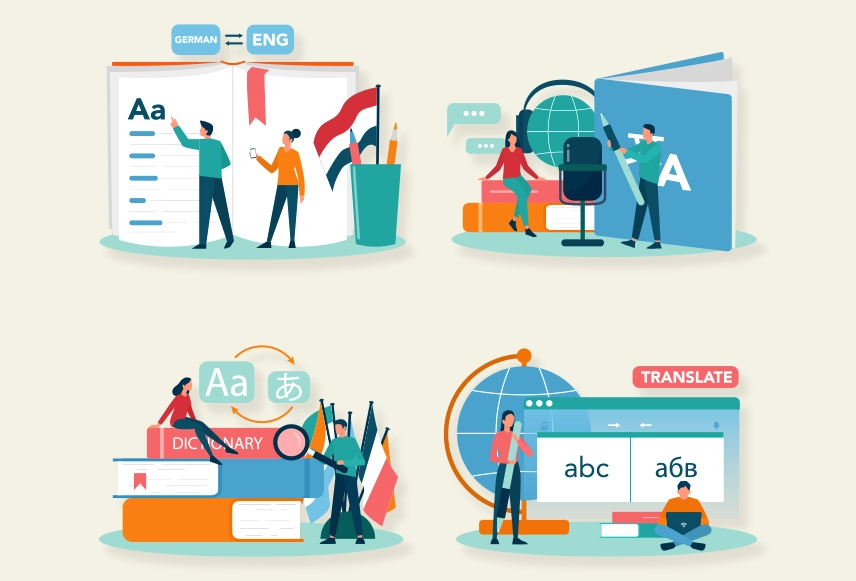
Content localization has become a key contributing factor for the success of global learning and training programs. According to eLearning Industry, 90% of individuals prefer learning in their native language. Content localization is a great way to keep learners engaged, involved, and inspired. It is used for different eLearning programs like corporate employee learning, compliance training, extended enterprise learning, technology training, and even academic learning.
Many organizations struggle with managing a large content library for global audiences. Tackling this challenge goes beyond simply translating content—it demands a holistic approach to localization. Let’s explore the significance of content localization in eLearning as well as effective strategies for achieving success with localization.
Table of Contents
Global Reach of eLearning
In our modern and interconnected world, advancements in technology and the internet have revolutionized learning, making it accessible to people worldwide. eLearning platforms provide convenient avenues for individuals to acquire new skills and enhance their knowledge. However, to truly reach and engage diverse audiences, organizations must overcome geographical and cultural barriers. This is where content localization comes into the picture.
What is Content Localization?
Often used interchangeably with content translation, localization can be defined as the process of adapting content and its assets to the context, language, culture, and preference of a target audience or market.
With content localization, you make your content look and sound more “local” by addressing cultural or region-specific nuances, linguistic, and contextual components. This includes accordingly making changes to content style, emojis, images, tone, phrases, spellings, hyperlinks, date and time formats, currency, colors, symbols, measurements, etc.
Importance of Content Localization

1. Embracing Linguistic Diversity
With a multitude of languages spoken globally, organizations and eLearning platforms face the challenge of catering to diverse linguistic backgrounds. Maximizing the impact of learning content entails more than simple translation—it requires adapting materials to accurately convey cultural nuances and linguistic intricacies in the native languages of learners.
By embracing content localization, organizations can ensure their learning materials resonate with learners from various cultural backgrounds, fostering inclusivity and enhancing the effectiveness of eLearning initiatives.
2. Cultural Relevance
Culture has a critical part to play in shaping the way individuals prefer to learn and behave. What may be effective in one culture might not necessarily work in another. Localization considers the cultural nuances, customs, and values to craft a learning experience that feels familiar and meaningful to the intended audience.
Imagine a multinational corporation developing an online training module on workplace communication skills. In one culture, direct and assertive communication styles are valued, while in another, indirect and harmonious communication styles are preferred.
In this scenario, content localization becomes crucial. To ensure cultural relevance, the eLearning module would need to include examples, scenarios, and case studies that reflect the communication norms and preferences of each target culture.
Now, imagine a multinational software company dedicated to nurturing the growth and development of its employees across different cultural contexts, such as those of India and the USA. In India, where career paths often intersect with familial and societal expectations, the company would offer eLearning modules focusing on technical prowess and certifications highly regarded in fields like software engineering and project management.
Additionally, recognizing the importance of leadership skills in India’s corporate landscape, the company would provide courses on effective team management and navigating hierarchical structures.
In contrast, in the USA, where individualism and entrepreneurial spirits thrive, the company’s eLearning content would prioritize innovation and creative thinking. Employees would have access to modules centered around agile methodologies, design thinking principles, and emerging technologies. Soft skills, such as effective communication, would also be emphasized to align with the collaborative and dynamic nature of American workplaces.
By tailoring eLearning initiatives to meet the unique needs and aspirations of employees in India and the USA, the software company would foster a culture of continuous learning and professional growth. This will ensure each individual has the tools and knowledge to thrive in their respective career journeys.
3. Contextual Adaptation
Context is crucial in learning. When localizing content, it’s essential to adjust examples, scenarios, and case studies to fit the cultural and societal contexts of learners. This ensures the content not only resonates with the audience but also becomes more applicable and relatable to real-life situations.
Imagine you’re enrolled in an online customer service training program offered by a global eLearning platform. In one part of the course, you learn how to handle customer complaints. For learners in the USA, the scenarios might feature situations you’d commonly encounter in American stores or restaurants, like dealing with returns or resolving billing errors.
Now, picture the same course, but tailored for learners in Japan. Here, the examples would reflect the cultural emphasis on politeness and respect. You might practice responding to customer feedback with utmost courtesy, even in challenging situations, as is customary in the Japanese culture.
Next, think about learners in Brazil. In their version of the course, the focus might shift to building strong relationships with customers. You could explore scenarios where empathy and interpersonal skills are essential for resolving issues and maintaining positive customer connections, reflecting the importance of personal connections in the Brazilian business culture.
By customizing examples and scenarios to match the cultural context of each group of learners, the eLearning experience feels more personal and relevant. This helps ensure everyone is able to effectively apply their newfound skills in real-life situations.
Take your eLearning content development to the next level with Harbinger’s intelligent content automation framework and AI-based learning solutions like automated localization and translation.
Effective Content Localization Strategy

1. Enabling Thorough Needs Assessment
Before diving into the localization process, it’s vital to have a deep understanding of the demographics, cultural intricacies, and linguistic preferences of the target audience. This foundational knowledge lays the groundwork for a successful localization journey.
2. Investing in Quality Translation Services
While machine translation tools have made significant advancements, nothing beats the precision and cultural sensitivity offered by human translators. Investing in professional translation services ensures the translated content remains accurate and culturally appropriate, resonating with the audience on a deeper level.
Learn how Harbinger helped a global leadership consulting company establish a QA process for content development and translation. Know how we created ground-level guidelines for their QA consultant and translation vendor.
3. Promoting Cultural Sensitivity
It’s essential to provide cultural sensitivity training to content creators, instructional designers, and L&D. By educating them about the cultural nuances of the target audience, you can prevent unintentional cultural insensitivity and ensure the learning content effectively aligns with the values and norms of learners.
4. Designing for Adaptability
When creating eLearning materials, prioritize adaptable designs that can easily accommodate changes in language and content structure. This approach not only streamlines the localization process but also makes it more efficient and cost-effective, ensuring the content remains relevant and engaging across diverse cultural contexts.
5. Testing for Localization Success
Before rolling out localized content, conduct thorough testing with representatives from the target audience. This step helps identify any potential cultural or linguistic issues and ensures a seamless learning experience for learners. By involving the audience in the testing phase, you can fine-tune the content to better meet their needs and expectations.
Navigating Challenges and Anticipating Future Trends
While content localization presents its fair share of challenges—including costs, time constraints, consistency issues, and regional variations—there’s optimism about the potential for advancements in AI and machine learning to revolutionize the localization process. Automated tools with the ability to understand cultural nuances hold the promise of making eLearning more localized and accessible on a global scale.
Unlock the potential of Generative AI-based automated translation! Learn about the advancements, benefits, and 6 steps to enable AI-based automation translation.
In Summary
Content localization is indispensable for the success of eLearning initiatives by global organizations. By embracing localization strategies, you can not only break down barriers but also provide an inclusive learning experience for learners worldwide. As we look ahead, the ongoing evolution of technology promises exciting possibilities for making learning accessible and localized for everyone, regardless of their cultural background or geographical location.
Would you like to implement content localization? Want to leverage our machine learning-based localization or automated translation solutions to future-proof eLearning content development? Reach out to us at contact@harbingergroup.com.






